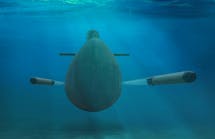By John Keller
Editor in Chief
The U.S. Army’s Future Combat Systems (FCS) program, a mammoth initiative to design and field families of manned and unmanned armored vehicles, unmanned aerial vehicles (UAVs), and the networking and data communications necessary to link its systems together for decision support and situational awareness, appears to be finished–at least as originally conceived.
Earlier this summer, the Army officially cancelled the $160 billion FCS program with the signing of an acquisition defense memorandum that gutted the program of its manned combat vehicle component, a family of armored vehicles based on a common chassis. Instead, the Army is restructuring what is left of FCS to emphasize unmanned ground vehicles and UAVs, communications networking, and sensors linked on communications networks. The new initiative to replace FCS is called Army Brigade Combat Team Modernization.
The FCS program has already yielded much important technology, including the Small Unmanned Ground Vehicle and the Warfighter Information Network–Tactical. Despite its valuable developments, the FCS program had a lot of problems–many of which were political, not technological.
The first problem involved the anticipated FCS mission: improving the Army’s ability to go toe-to-toe with large national mechanized forces of major military powers. FCS was not so much about dealing with military imperatives of fighting unconventional forces and terrorists, who rely on roadside bombs and other improvised explosive devices, as it was about confronting large national forces equipped with tanks and artillery.
The second problem with FCS was its sheer size. While most military programs are concerned with one platform at a time, the FCS packaged many platforms together as a monolithic move into the future. Proponents believed the program was not only a logical and integrated step toward modernization, but also too big to fail.
Actually, the program was too large and juicy a target to survive. It was easy for political opponents to attack on Capitol Hill and in the Pentagon–a large, lumbering, fantastically expensive program with fragmented constituencies that could be set against one another with ease.
In the military today, there are few rivalries as fierce as the manned vs. unmanned vehicle communities. Tank drivers, artillery commanders, and helicopter pilots often look on unmanned vehicles with scorn. They have convinced themselves that their manned platforms can do a better job; they also know that unmanned vehicles threaten their jobs.
The FCS program contained both of these components as cornerstones. It was nearly inevitable that the program eventually would turn on itself.
We’ve seen much the same thing happen before. In 1984, then-President Ronald Reagan envisioned the Strategic Defense Initiative (SDI), which became known as the Star Wars missile defense research program. SDI brought together many separate ballistic missile defense programs under the Aegis of the Strategic Defense Initiative Organization. In its nine years of existence, SDI not only created breakthrough technology that we are seeing deployed today, but also was a political lightning rod, which its well-organized opposition took delight in bashing.
Eventually the SDI program was whittled down, and its name changed to the Ballistic Missile Defense program. The SDI program, like FCS, made too big a target to survive.
Legacy components of the FCS program will live on. These most likely will involve new generations of unmanned ground vehicles and battlefield tactical networking. The demise of the FCS program also paves the way to new research programs to develop next-generation battle tanks, artillery, and armored personnel carriers.



